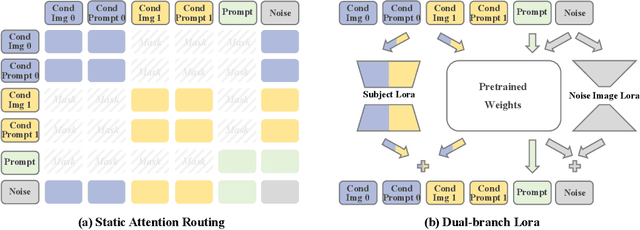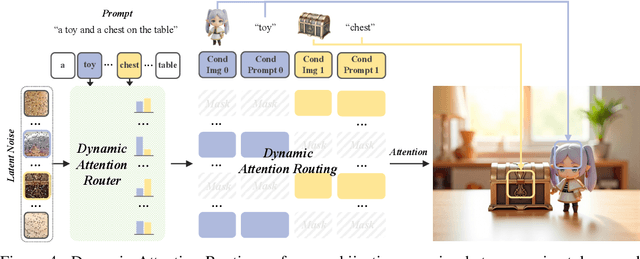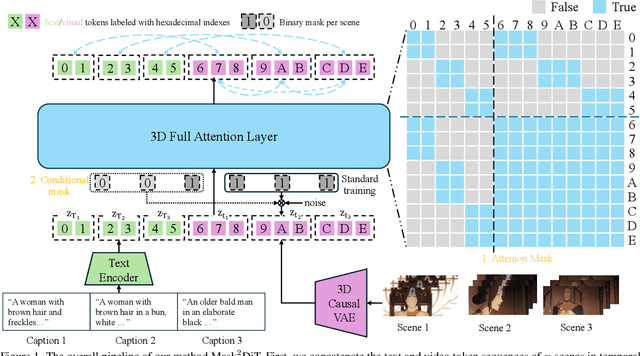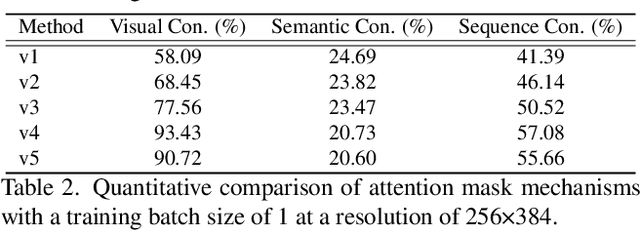Qian He
HuMo: Human-Centric Video Generation via Collaborative Multi-Modal Conditioning
Sep 10, 2025Abstract:Human-Centric Video Generation (HCVG) methods seek to synthesize human videos from multimodal inputs, including text, image, and audio. Existing methods struggle to effectively coordinate these heterogeneous modalities due to two challenges: the scarcity of training data with paired triplet conditions and the difficulty of collaborating the sub-tasks of subject preservation and audio-visual sync with multimodal inputs. In this work, we present HuMo, a unified HCVG framework for collaborative multimodal control. For the first challenge, we construct a high-quality dataset with diverse and paired text, reference images, and audio. For the second challenge, we propose a two-stage progressive multimodal training paradigm with task-specific strategies. For the subject preservation task, to maintain the prompt following and visual generation abilities of the foundation model, we adopt the minimal-invasive image injection strategy. For the audio-visual sync task, besides the commonly adopted audio cross-attention layer, we propose a focus-by-predicting strategy that implicitly guides the model to associate audio with facial regions. For joint learning of controllabilities across multimodal inputs, building on previously acquired capabilities, we progressively incorporate the audio-visual sync task. During inference, for flexible and fine-grained multimodal control, we design a time-adaptive Classifier-Free Guidance strategy that dynamically adjusts guidance weights across denoising steps. Extensive experimental results demonstrate that HuMo surpasses specialized state-of-the-art methods in sub-tasks, establishing a unified framework for collaborative multimodal-conditioned HCVG. Project Page: https://phantom-video.github.io/HuMo.
USO: Unified Style and Subject-Driven Generation via Disentangled and Reward Learning
Aug 26, 2025Abstract:Existing literature typically treats style-driven and subject-driven generation as two disjoint tasks: the former prioritizes stylistic similarity, whereas the latter insists on subject consistency, resulting in an apparent antagonism. We argue that both objectives can be unified under a single framework because they ultimately concern the disentanglement and re-composition of content and style, a long-standing theme in style-driven research. To this end, we present USO, a Unified Style-Subject Optimized customization model. First, we construct a large-scale triplet dataset consisting of content images, style images, and their corresponding stylized content images. Second, we introduce a disentangled learning scheme that simultaneously aligns style features and disentangles content from style through two complementary objectives, style-alignment training and content-style disentanglement training. Third, we incorporate a style reward-learning paradigm denoted as SRL to further enhance the model's performance. Finally, we release USO-Bench, the first benchmark that jointly evaluates style similarity and subject fidelity across multiple metrics. Extensive experiments demonstrate that USO achieves state-of-the-art performance among open-source models along both dimensions of subject consistency and style similarity. Code and model: https://github.com/bytedance/USO
Phantom-Data : Towards a General Subject-Consistent Video Generation Dataset
Jun 23, 2025Abstract:Subject-to-video generation has witnessed substantial progress in recent years. However, existing models still face significant challenges in faithfully following textual instructions. This limitation, commonly known as the copy-paste problem, arises from the widely used in-pair training paradigm. This approach inherently entangles subject identity with background and contextual attributes by sampling reference images from the same scene as the target video. To address this issue, we introduce \textbf{Phantom-Data, the first general-purpose cross-pair subject-to-video consistency dataset}, containing approximately one million identity-consistent pairs across diverse categories. Our dataset is constructed via a three-stage pipeline: (1) a general and input-aligned subject detection module, (2) large-scale cross-context subject retrieval from more than 53 million videos and 3 billion images, and (3) prior-guided identity verification to ensure visual consistency under contextual variation. Comprehensive experiments show that training with Phantom-Data significantly improves prompt alignment and visual quality while preserving identity consistency on par with in-pair baselines.
MUSAR: Exploring Multi-Subject Customization from Single-Subject Dataset via Attention Routing
May 05, 2025



Abstract:Current multi-subject customization approaches encounter two critical challenges: the difficulty in acquiring diverse multi-subject training data, and attribute entanglement across different subjects. To bridge these gaps, we propose MUSAR - a simple yet effective framework to achieve robust multi-subject customization while requiring only single-subject training data. Firstly, to break the data limitation, we introduce debiased diptych learning. It constructs diptych training pairs from single-subject images to facilitate multi-subject learning, while actively correcting the distribution bias introduced by diptych construction via static attention routing and dual-branch LoRA. Secondly, to eliminate cross-subject entanglement, we introduce dynamic attention routing mechanism, which adaptively establishes bijective mappings between generated images and conditional subjects. This design not only achieves decoupling of multi-subject representations but also maintains scalable generalization performance with increasing reference subjects. Comprehensive experiments demonstrate that our MUSAR outperforms existing methods - even those trained on multi-subject dataset - in image quality, subject consistency, and interaction naturalness, despite requiring only single-subject dataset.
DreamO: A Unified Framework for Image Customization
Apr 23, 2025Abstract:Recently, extensive research on image customization (e.g., identity, subject, style, background, etc.) demonstrates strong customization capabilities in large-scale generative models. However, most approaches are designed for specific tasks, restricting their generalizability to combine different types of condition. Developing a unified framework for image customization remains an open challenge. In this paper, we present DreamO, an image customization framework designed to support a wide range of tasks while facilitating seamless integration of multiple conditions. Specifically, DreamO utilizes a diffusion transformer (DiT) framework to uniformly process input of different types. During training, we construct a large-scale training dataset that includes various customization tasks, and we introduce a feature routing constraint to facilitate the precise querying of relevant information from reference images. Additionally, we design a placeholder strategy that associates specific placeholders with conditions at particular positions, enabling control over the placement of conditions in the generated results. Moreover, we employ a progressive training strategy consisting of three stages: an initial stage focused on simple tasks with limited data to establish baseline consistency, a full-scale training stage to comprehensively enhance the customization capabilities, and a final quality alignment stage to correct quality biases introduced by low-quality data. Extensive experiments demonstrate that the proposed DreamO can effectively perform various image customization tasks with high quality and flexibly integrate different types of control conditions.
DreamID: High-Fidelity and Fast diffusion-based Face Swapping via Triplet ID Group Learning
Apr 20, 2025Abstract:In this paper, we introduce DreamID, a diffusion-based face swapping model that achieves high levels of ID similarity, attribute preservation, image fidelity, and fast inference speed. Unlike the typical face swapping training process, which often relies on implicit supervision and struggles to achieve satisfactory results. DreamID establishes explicit supervision for face swapping by constructing Triplet ID Group data, significantly enhancing identity similarity and attribute preservation. The iterative nature of diffusion models poses challenges for utilizing efficient image-space loss functions, as performing time-consuming multi-step sampling to obtain the generated image during training is impractical. To address this issue, we leverage the accelerated diffusion model SD Turbo, reducing the inference steps to a single iteration, enabling efficient pixel-level end-to-end training with explicit Triplet ID Group supervision. Additionally, we propose an improved diffusion-based model architecture comprising SwapNet, FaceNet, and ID Adapter. This robust architecture fully unlocks the power of the Triplet ID Group explicit supervision. Finally, to further extend our method, we explicitly modify the Triplet ID Group data during training to fine-tune and preserve specific attributes, such as glasses and face shape. Extensive experiments demonstrate that DreamID outperforms state-of-the-art methods in terms of identity similarity, pose and expression preservation, and image fidelity. Overall, DreamID achieves high-quality face swapping results at 512*512 resolution in just 0.6 seconds and performs exceptionally well in challenging scenarios such as complex lighting, large angles, and occlusions.
Less-to-More Generalization: Unlocking More Controllability by In-Context Generation
Apr 02, 2025Abstract:Although subject-driven generation has been extensively explored in image generation due to its wide applications, it still has challenges in data scalability and subject expansibility. For the first challenge, moving from curating single-subject datasets to multiple-subject ones and scaling them is particularly difficult. For the second, most recent methods center on single-subject generation, making it hard to apply when dealing with multi-subject scenarios. In this study, we propose a highly-consistent data synthesis pipeline to tackle this challenge. This pipeline harnesses the intrinsic in-context generation capabilities of diffusion transformers and generates high-consistency multi-subject paired data. Additionally, we introduce UNO, which consists of progressive cross-modal alignment and universal rotary position embedding. It is a multi-image conditioned subject-to-image model iteratively trained from a text-to-image model. Extensive experiments show that our method can achieve high consistency while ensuring controllability in both single-subject and multi-subject driven generation.
Mask$^2$DiT: Dual Mask-based Diffusion Transformer for Multi-Scene Long Video Generation
Mar 25, 2025



Abstract:Sora has unveiled the immense potential of the Diffusion Transformer (DiT) architecture in single-scene video generation. However, the more challenging task of multi-scene video generation, which offers broader applications, remains relatively underexplored. To bridge this gap, we propose Mask$^2$DiT, a novel approach that establishes fine-grained, one-to-one alignment between video segments and their corresponding text annotations. Specifically, we introduce a symmetric binary mask at each attention layer within the DiT architecture, ensuring that each text annotation applies exclusively to its respective video segment while preserving temporal coherence across visual tokens. This attention mechanism enables precise segment-level textual-to-visual alignment, allowing the DiT architecture to effectively handle video generation tasks with a fixed number of scenes. To further equip the DiT architecture with the ability to generate additional scenes based on existing ones, we incorporate a segment-level conditional mask, which conditions each newly generated segment on the preceding video segments, thereby enabling auto-regressive scene extension. Both qualitative and quantitative experiments confirm that Mask$^2$DiT excels in maintaining visual consistency across segments while ensuring semantic alignment between each segment and its corresponding text description. Our project page is https://tianhao-qi.github.io/Mask2DiTProject.
AR-Diffusion: Asynchronous Video Generation with Auto-Regressive Diffusion
Mar 10, 2025Abstract:The task of video generation requires synthesizing visually realistic and temporally coherent video frames. Existing methods primarily use asynchronous auto-regressive models or synchronous diffusion models to address this challenge. However, asynchronous auto-regressive models often suffer from inconsistencies between training and inference, leading to issues such as error accumulation, while synchronous diffusion models are limited by their reliance on rigid sequence length. To address these issues, we introduce Auto-Regressive Diffusion (AR-Diffusion), a novel model that combines the strengths of auto-regressive and diffusion models for flexible, asynchronous video generation. Specifically, our approach leverages diffusion to gradually corrupt video frames in both training and inference, reducing the discrepancy between these phases. Inspired by auto-regressive generation, we incorporate a non-decreasing constraint on the corruption timesteps of individual frames, ensuring that earlier frames remain clearer than subsequent ones. This setup, together with temporal causal attention, enables flexible generation of videos with varying lengths while preserving temporal coherence. In addition, we design two specialized timestep schedulers: the FoPP scheduler for balanced timestep sampling during training, and the AD scheduler for flexible timestep differences during inference, supporting both synchronous and asynchronous generation. Extensive experiments demonstrate the superiority of our proposed method, which achieves competitive and state-of-the-art results across four challenging benchmarks.
GLAM: Global-Local Variation Awareness in Mamba-based World Model
Jan 21, 2025



Abstract:Mimicking the real interaction trajectory in the inference of the world model has been shown to improve the sample efficiency of model-based reinforcement learning (MBRL) algorithms. Many methods directly use known state sequences for reasoning. However, this approach fails to enhance the quality of reasoning by capturing the subtle variation between states. Much like how humans infer trends in event development from this variation, in this work, we introduce Global-Local variation Awareness Mamba-based world model (GLAM) that improves reasoning quality by perceiving and predicting variation between states. GLAM comprises two Mambabased parallel reasoning modules, GMamba and LMamba, which focus on perceiving variation from global and local perspectives, respectively, during the reasoning process. GMamba focuses on identifying patterns of variation between states in the input sequence and leverages these patterns to enhance the prediction of future state variation. LMamba emphasizes reasoning about unknown information, such as rewards, termination signals, and visual representations, by perceiving variation in adjacent states. By integrating the strengths of the two modules, GLAM accounts for highervalue variation in environmental changes, providing the agent with more efficient imagination-based training. We demonstrate that our method outperforms existing methods in normalized human scores on the Atari 100k benchmark.
 Add to Chrome
Add to Chrome Add to Firefox
Add to Firefox Add to Edge
Add to Edge